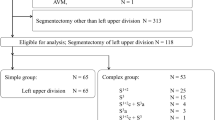Abstract
Objectives
Despite the ubiquitous utilization of anatomical sublobar resection for malignant lung tumors, the effectiveness and feasibility of subsegmentectomy remains unclear. This study therefore compared the perioperative outcomes between anatomical sublobar resection including (IS) and excluding (ES) subsegmentectomy.
Methods
Patients who had undergone anatomical sublobar resection at our institution from January 2013 to March 2019 were retrospectively reviewed. Clinicopathologic characteristics and perioperative outcomes of the IS group (n = 58) were then analyzed the compared to those of the ES group (n = 203).
Results
No statistically significant differences in age, sex, comorbidities, tumor location, preoperative pulmonary function, or tumor size on imaging were found between both groups. The IS group had significantly higher preoperative computed tomography-guided marking rates (40% vs. 18%; p < 0.01) and used significantly more staplers for intersegmental dissection than the ES group [4, interquartile range (IQR): 3–4 vs. 3, IQR: 3–4; p = 0.03]. Both groups had comparable 30-day mortality (0% vs. 0%; p > 0.99), intraoperative complications (7% vs. 10%; p = 0.61), and postoperative complications (5% vs. 8%; p = 0.58). After propensity score matching, the IS group experienced significantly lesser blood loss than the ES group (5 mL, IQR: 1–10 vs. 5 mL, IQR: 5–20; p = 0.03). Both groups experienced no local recurrence and demonstrated similar postoperative pulmonary functions after surgery.
Conclusions
IS may be a feasible and acceptable therapeutic option for malignant lung tumors. Nonetheless, future investigations are required to further validate the current findings.



Similar content being viewed by others
Abbreviations
- CT:
-
Computed tomography
- ES:
-
Anatomical sublobar resection excluding subsegmentectomy
- FEV1 :
-
Forced expiratory volume in 1.0 s
- FVC:
-
Forced vital capacity
- IQR:
-
Interquartile range
- IS:
-
Anatomical sublobar resection including subsegmentectomy
- MRI:
-
Magnetic resonance imaging
- NSCLC:
-
Non-small cell lung cancer
- PET:
-
Positron emission tomography
References
Ginsberg RJ, Rubinstein LV. Randomized trial of lobectomy versus limited resection for T1 N0 non-small lung cancer. Lung Cancer Study Group. Ann Thorac Surg. 1995;60:615–22.
Goya T, Asamura H, Yoshimura H, Kato H, Shimokata K, Tsuchiya R, et al. Prognosis of 6644 resected non-small cell lung cancers in Japan: a Japanese lung cancer registry study. Lung Cancer. 2005;50:227–34.
Okada M, Sakamoto T, Nishio W, Uchino K, Tsubota N. Characteristics and prognosis of patients after resection of nonsmall cell lung carcinoma measuring 2 cm or less in greatest dimension. Cancer. 2003;98:535–41.
Schuchert MJ, Pettiford BL, Keeley S, D’Amato TA, Kilic A, Close J, et al. Anatomic segmentectomy in the treatment of stage I non-small cell lung cancer. Ann Thorac Surg. 2007;84:926–32.
Tsutani Y, Miyata Y, Nakayama H, Okumura S, Adachi S, Yoshimura M, et al. Appropriate sublobar resection choice for ground glass opacity-dominant clinical stage IA lung adenocarcinoma: wedge resection or segmentectomy. Chest. 2014;145:66–71.
Suzuki K, Saji H, Aokage K, Watanabe S, Okada M, Mizusawa J, et al. Comparison of pulmonary segmentectomy and lobectomy: safety results of a randomized trial. J Thorac Cardiovasc Surg. 2019;158:895–907.
Nakamoto K, Omori K, Nezu K, Lung Cancer Project Group of West-Seto Inland Sea, Japan. Superselective segmentectomy for deep and small pulmonary nodules under the guidance of three-dimensional reconstructed computed tomographic angiography. Ann Thorac Surg. 2010;89:877–83.
Yoshimoto K, Nomori H, Mori T, Ohba Y, Shiraishi K, Ikeda K. Combined subsegmentectomy: postoperative pulmonary function compared to multiple segmental resection. J Cardiothorac Surg. 2011;6:17.
Sekine Y, Itoh T, Toyoda T, Kaiho T, Koh E, Kamata T, et al. Precise anatomical sublobar resection using a 3D medical image analyzer and fluorescence-guided surgery with transbronchial instillation of indocyanine green. Semin Thorac Cardiovasc Surg. 2019;31:595–602.
Kaseda S, Aoki T, Hangai N, Shimizu K. Better pulmonary function and prognosis with video-assisted thoracic surgery than with thoracotomy. Ann Thorac Surg. 2000;70:1644–6.
Detterbeck FC, Boffa DJ, Kim AW, Tanoue LT. The eighth edition lung cancer stage classification. Chest 2017; 151:193–203.
Hasegawa T, Kuroda H, Sato Y, Matsuo K, Sakata S, Yashiro H, et al. The utility of indigo carmine and lipiodol mixture for preoperative pulmonary nodule localization before video-assisted thoracic surgery. J Vasc Interv Radiol. 2019;30:446–52.
Takahashi Y, Matsutani N, Morita S, Dejima H, Nakayama T, Uehara H, et al. Predictors of long-term compensatory response of pulmonary function following major lung resection for non-small cell lung cancer. Respirology. 2017;22:364–71.
Harada H, Okada M, Sakamoto T, Matsuoka H, Tsubota N. Functional advantage after radical segmentectomy versus lobectomy for lung cancer. Ann Thorac Surg. 2005;80:2041–5.
Handa Y, Tsutani Y, Mimae T, Tasaki T, Miyata Y, Okada M. Surgical outcomes of complex versus simple segmentectomy for stage I non-small cell lung cancer. Ann Thorac Surg. 2019;107:1032–9.
Higashiyama M, Kodama K, Takami K, Higaki N, Nakayama T, Yokouchi H. Intraoperative lavage cytologic analysis of surgical margins in patients undergoing limited surgery of lung cancer. J Thorac Cardiovasc Surg. 2003;125:101–7.
El-Sherif A, Fernando HC, Santos R, Pettiford B, Luketich JD, Close JM, et al. Margin and local recurrence after sublobar resection of non-small cell lung cancer. Ann Surg Oncol. 2007;14:2400–5.
Sawabata N, Ohta M, Matsumura A, Nakagawa K, Hirano H, Maeda H, et al. Optimal distance of malignant negative margin in excision of non-small cell lung cancer: a multicenter prospective study. Ann Thorac Surg. 2004;77:415–20.
Funding
None.
Author information
Authors and Affiliations
Corresponding author
Ethics declarations
Conflict of interest
The authors declare that they have no competing interests.
Additional information
Publisher's Note
Springer Nature remains neutral with regard to jurisdictional claims in published maps and institutional affiliations.
Supplementary Information
Below is the link to the electronic supplementary material.
Supplementary file2 (MP4 217746 KB)
Rights and permissions
About this article
Cite this article
Matsui, T., Takahashi, Y., Shirai, S. et al. Comparison of surgical outcomes between thoracoscopic anatomical sublobar resection including and excluding subsegmentectomy. Gen Thorac Cardiovasc Surg 69, 850–858 (2021). https://doi.org/10.1007/s11748-020-01556-3
Received:
Accepted:
Published:
Issue Date:
DOI: https://doi.org/10.1007/s11748-020-01556-3




